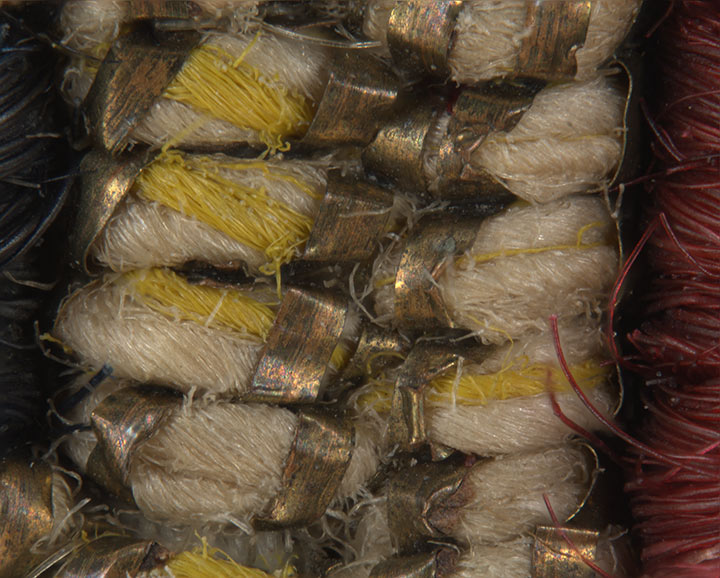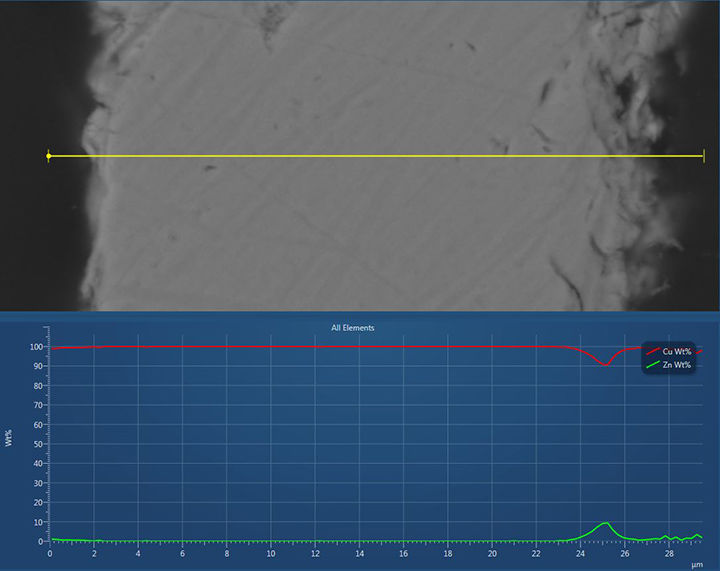Conservators and scientists at The Met took a close look at the golden metallic thread used in a double saddlebag from the market town of Reyhanlı and discovered some interesting facts about it.
Double saddlebag (Heybe), ca. 1880. Southern Turkey, Reyhanli area, Hatay. The Metropolitan Museum of Art, New York, Gift of Inger G. and William B. Ginsberg, 2015 (2015.490.29)
The scientific analysis of the constituent materials of artworks can reveal useful information about manufacturing processes and patterns of trade and use. To characterize the alloy composition and manufacture technology of the golden metallic thread used in this double saddlebag, conservators and scientists analyzed it using both visible light and scanning electron microscopy.

A magnified view showing the gold-looking strip in visible light
The analysis in visible light revealed that a strip of metal was wrapped around a textile core with a Z twist (above). The wrapped metal strip is about 390 µm wide and 25 µm thick and has very round edges.

A section of the copper strip as seen under the scanning electron microscope
Chemical analysis identifies the metal as unalloyed pure copper (≥ 99.9%) with traces of iron and sulfur present as small inclusions.

Chemical analysis of the copper strip shows an enrichment in zinc (Zn, green line) at its surface
Analysis of the metal strip identified a thin, slightly discontinuous layer rich in zinc at its surface (above). The presence of a layer of zinc that decreases towards the center of the strip indicates that the metal was treated to create a layer of brass (an alloy of copper and zinc) that would look like gold, most likely by exposing a copper wire to zinc vapor before it was flattened and reduced to a thin strip.[1]
The production of copper metallic threads that resembled gold was first patented in Europe in the mid-18th century.[2] By the end of the 19th century, gold-looking copper wires and threads were commonly available as a cheap substitute for more precious gold and gilded varieties.[3]
The analysis of the metallic thread of the Portable Storage double saddlebag shows that the thread was produced in an industrial workshop, most likely in Europe. The metallic thread then travelled thousands of miles to get to the Near East, where it was bought on the market before being used in the construction of this bag.
To learn more about this bag, see Reyhanlı: A Market Town.
[1] Márta Láró, Tamás Gál, and Attila Tóth, "The Characterization and Determination of Modern Metallic Threads," Studies in Conservation 45.2 (2000): 95–105.
[2] Barbara A. Schreier and Randall R. Bresee, "History of Decorative Metallic Yarns," in Book of Papers. National Technical Conference AATCC (Delaware, 1979): 137–40.
[3] Vanessa Muros et al., "Characterization of 17th–19th Century Metal Threads from the Colonial Andes," Journal of the American Institute for Conservation 46.3: 229–44.
Author: Federico Caro, Associate Research Scientist, Department of Scientific Research. © 2017 The Metropolitan Museum of Art, New York
Double saddle bag (Khorjin) (detail), ca. 1900. Northwestern Iran or Azerbaijan, Shahsevan tribe. Wool (warp and sumak weft) and cotton (ground weft); sumak extra weft wrapping (front) and weft-faced plain weave with pattern in brocaded weft (back), 52 x 20 in. (132.1 x 50.8 cm). The Metropolitan Museum of Art, New York, Gift of Inger G. and William B. Ginsberg, 2015 (2015.490.43). Photo by Walter B. Denny